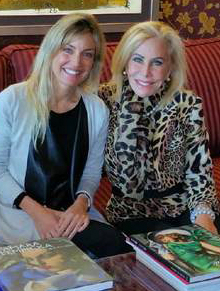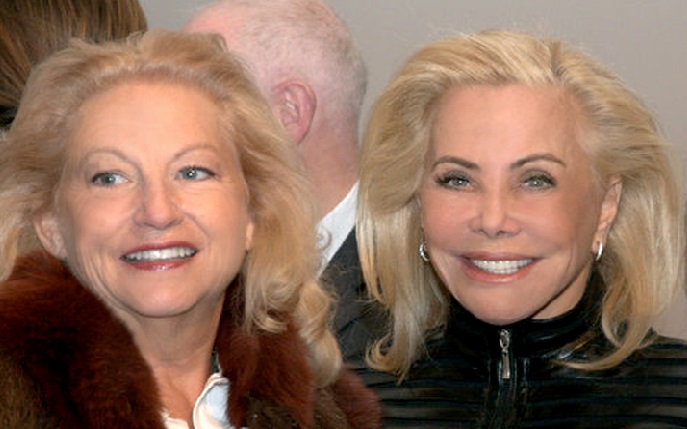Marilyn
Goldberg

Marisa Doporto (left) with Marilyn Goldberg (right)

Victoria de Lempicka (left) with Marilyn Goldberg (right)
„There are no miracles, there is only what you make.“
Tamara de Lempicka
Diva of Luxury
by © Marilyn Goldberg 2011 Museum Masters International
It has been long accepted throughout the international art world today that Tamara de Lempicka in her very singular way, brilliantly captured the whirlwind decade of the 1920’s on canvas by painting the portraits of the illustrious and renowned socialites of Europe. She created the style of painting, which we now know as „Art Deco”. Hers was the era of flappers, fashion, music, and politics at a time when the stock market crashed in 1929 followed by many years of The Great Depression. Tamara captured it all including the epic transition from simple modes of transportation to the advent of the automobile. And in one especially grand piece; Tamara’s self portrait „Tamara in Green Bugatti” her iconic statement of self!
Maria Tamara Gorwik Gorska, later self-ordained „Tamara de Lempicka”, was born in Warsaw, Poland. She was sent to the wealthiest boarding school in Lausanne, Switzerland. On her holidays during her youth at the hand and direction of her great aunt Stephanie, she was introduced to imported French luxuries from Maison Jansen, and jewels of all colors and shapes which Stephanie used for lavish balls of The Emperor Nicolas II. Tamara as then a strikingly beautiful ingénue envisioned for herself a life of grace, class, wealth and of course, haute couture.
Tamara had by 1916 chosen the most eligible and handsome bachelor in Warsaw, an attorney named Tadeusz Lempicki. The marriage of this most enviable couple took place in St. Petersburg nearby the magnificent State Hermitage Museum. Tragically, Tadeusz wasthen arrested by the Bolsheviks. Tamara did everything possible during the Russian Revolution with her exquisite looks, flair for fashion and charming personality to acquire the favor of the Swedish counsel in order to secure the release of Tadeusz. The couple had to flee to grand Paris where Tamara studied with all the Polish and Russianof influence and class who already knew the French ways. Her incredible future awaited her! Having studied art in St. Petersburg’s she decided to paint portraits. She won her first major award in 1927 which was the first prize medal for „Kizette on the Balcony” at the exposition in Bordeaux.
In her early days of poverty in Paris, having studied art in Warsaw, Tamara always traveled with a small canvas portfolio of her very first painting and her very first school medals for art excellence for which she was unceasingly proud, and wanted them always to stay in the family and heritage. Later in her career she offered to thicken the layers of oil on canvas, however, she continued to carry her first portfolio from St. Petersburg and kept it by her side always. Her drawings and paintings at the time were small sketch pads, canvases and thin layers of oil on canvas until later in her career when she could finally afford to thicken the layers of paint so that the canvases would be more lush in quality.
While in Paris, she soon adopted the name Tamara de Lempicka – (as everyone in Paris had a „de” before their fancy names). Her mother instilled in her daughter, Tamara, the need for her to have titles in order to attract the right social climate. She signed her works „T. Lempicki” instead of the Polish feminine way and changed it to „Lempicka“.
Her paintings between the wars were portraits of the renowned and elite socialites, which Tamara co-branded herself by attaching her name to the royal families of Europe including those with titles. Her daughter, The Baroness Kizette de Lempicka-Foxhall wrote in her book „Passion by Design” published by Abbeville Press; „She painted them all, the rich, the famous and renowned … the best and with many she had love affairs.” Tamara’s iconic paintings of the Jazz age, the period between the wars, remain forever to remind us of the elegance and frivolity of that period.
At the onset of World War II, The Baroness and Baron Raoul Kuffner departed from Paris. They settled in Hollywood in the former King Vidor Estate. He was one of her earliest and wealthiest collectors. The house was previously owned by Hungarian movie director, King Vidor who had completed the movie War and Peace. The couple then moved to East 57th Street, (the early corridor of the abstract and impressionist art world) in New York City in 1943. Tamara put her interior design talents to use in her dramatic two story studio where everything from the floors, to the drapery, to the pearl gray upholstery was adorned. Tamara waited patiently for the war to end and when it was over she returned to the street she loved best and was most inspired by, The Rue Mechain in Paris where she designed her own special décor and surroundings once again but this time in the Rococo Style known as „Late Baroque.”
In 1978 Tamara moved to a beautiful and peaceful Villa designed by a Japanese architect in Cuernavaca, Mexico. She could not easily adjust to her aging appearance in the mirror so she surrounded herself with young attractive and passionate people and wanted to be remembered for her talent and style. She wanted to be cremated and remembered as she was in Paris, the most beautiful portrait painter of her day.
Abstract art mid 20th century promoted American greats such as Jackson Pollack. Tamara tried to change her recipe blurring colors and dissolving shapes which were not well received, The Baroness Kuffner’s pride was damaged; she no longer wanted to play the game of winning and never exhibited her work again. Tamara de Lempicka died in her sleep on March 18, 1980. Her daughter Kizette was at her side and spread her ashes as she wished on top of the Volcano – Popocatepetl.
In 1966 The Musee des Arts Decoratifs created a Paris exhibition called „Les Annees 25.” The elegance and the success of the show created a serious Art Deco revival and inscribed Tamara with another Deco great „Erte”. Later Mr. Alain Blondel of Paris inspired by her work opened The Galarie du Luxemburg to launch a Tamara retrospective. This was followed by The Knoedler Gallery show which was organized by Mr. William Weber, an international art dealer living in Greenwich Village. Tamara made many demands on how the exhibition would be mounted and the curator from Knoedler dismissed it. Mr. William Weber, after completion of The Lempicka exhibition in Japan went years later to Rome to establish a relationship for a museum exhibition. Just after Tamara’s death, William Weber arranged for the Brain Trust Exhibition in Japan in her honor. This was planned and organized with the guidance and assistance of Marilyn Goldberg, whom he had introduced to Kizette and her daughter, Victoria, at the time of the Brain Trust Exhibit in Japan.
He requested his best friend, Marilyn Goldberg, before his trip to Rome where she devoted her creative time and energy to Victoria de Lempicka her granddaughter. In a sudden dramatic turn, a phone call was received at Museum Masters International that William Weber fell down the stairs of a large Rome museum and instantly died of a concussion. William Weber’s dream of a Rome exhibition was revived years later. Both Victoria de Lempicka and Marilyn Goldberg commemorate this exhibition to his memory to men from opposite sides of the world, Alain Blondel in Paris, and William Weber in New York who formulated the international impetus to bring Tamara de Lempicka to world audiences.
Now over two decades later I am proud to celebrate the inauguration at The Complesso del Vittoriano in Rome, Italy. Mr. William Weber, brought the exhibition solely to Japan to Brain Trust and engaged Marilyn Goldberg of Museum Masters International to attend and assist him. After the Japanese Brain Trust exhibition, Lempicka paintings were offered to The San Francisco Museum, Boston Museum of Fine Arts, The Royale Academy, Caixa de Galicia in Mexico, Austria Kunstforum Vienna, Palacio de Bellas Artes Mexico, The Bunkamura Museum of Art in Japan, Hyoto Prefectural Museum of Art in Japan followed by the Complesso del Vittoriano in Rome.
Today Lempicka paintings with by example the 2009 sale by Wolfgang Joop have brought skyrocketing prices up to 6.5 million euro! „On the Telephone“ which sold for $1.9 million in 2009 received an offer today for $3,200,000 US dollars!
The experience I have had for many years as owner and President of Museum Masters International Inc. of creative, transformative, and dynamic marketing on the international stage has been the thrill of a lifetime. I have designed the worldwide creative market for preserving the names of Da Vinci, Van Gogh, Picasso, Haring, Warhol, and Lempicka for younger generations to learn about and enjoy their works and history. I have had the great honor and pleasure to consult with and bring new innovative exhibitions and presentation models to the greatest Estates and Museums in the world from The Guggenheim Museum in New York, to the St. Hermitage in St. Petersburg Russia, and to develop programs for The Metropolitan Opera and The New York Philharmonic. Tamara and her paintings have captured my heart, spirit and soul.
I understand what she needed and wanted and how she played the game of winning for her own survival on her own terms. I am truly honored to participate in the Exhibition at The Complessa del Vittoriano and I dedicate the 2011 Exhibition of this woman far ahead of her time, and modern beyond today. So privileged am I to have worked closely with Victoria de Lempicka and with Two Men on both sides of the world who helped me find the earliest films of Tamara to fulfill her international marketing dream; William Weber who invited me to Japan to photograph her works and my dear friend, Alain Blondel in Paris who assisted me over 20 years ago in fulfilling my dream to develop her international marketing and bring Tamara’s inspiration to my life. Through her art I know that my life is blessed and that I have made the right choices. A very special thank you and my deepest vows of friendship to her granddaughter, Victoria de Lempicka.
© Marilyn Goldberg Museum Masters International February 2011